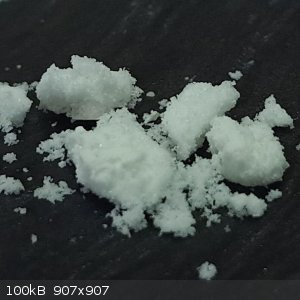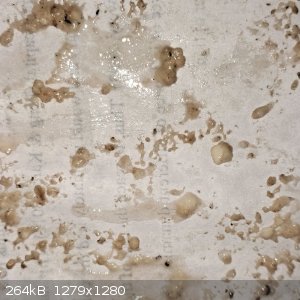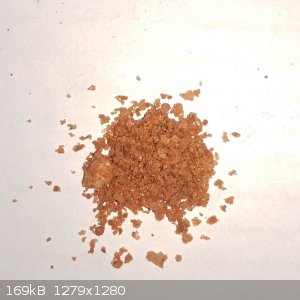gr4bb3r
Harmless

Posts: 7
Registered: 18-9-2023
Location: Tor network
Member Is Offline
Mood: Cooking
|
|
Differentiating K2CO3 and CaCl2
Hello everyone! I wanted some KCl, so I searched for cheap sources of KCl. I found that KCl is sold as fertilizer named MOP(Muriate of Potassium). I
bought it and realized that K2CO3 is also called MOP. So, I wanted to know if I had K2CO3 or KCl. I dissolved MOP in water and removed all the
impurities and boiled the water to get the salt. Then I dissolved the salt again by weighting it, and found out it wasn't KCl. Solubility of KCl is
way low in comparison to K2CO3 at same temperature. As I didn't wanted K2CO3, I was doing some random test that I could easily do and I did flame
test. I expected the flame to be somewhat of purple color, but the flame was of yellow color. Shouldn't the salt of potassium give purplish color?
That made me little suspicious that It was potassium salt. So another test that I could do was PH test. Potassium salt would be little basic and it
would turn a little blue when dipped in the solution of K2CO3 solution. But when I dipped PH paper in the salt solution, It was almost neutral(the PH
paper turned only a little green). That made me more suspicious. I left for some time and found that the salt was deliquescent. Now, that made me
suspect that I was dealing with CaCl2 because the flame test of Calcium gives yellowish color.(Link to flame test of calcium, not mine) . CaCl2 is also deliquescent and it is neutral solution. So, as a final confirmation for CaCl2, I
decided to do electrolysis of the solution I had. Because CaCl2 produces Ca(OH)2 on electrolysis, which precipitates out on cathode. But when I did
the electrolysis, there was no Ca(OH)2 precipitate on cathode. I am not suspecting it to be a Sodium salt since sodium salt aren't used in
fertilizers. I am very much confused and couldn't find any simple test to differentiate K2CO3 and CaCl2 in my case. I don't have access to any acids
but I can get NaOH, though it will take some time. Is there any test I can further do to differentiate it easily? Below are some images of mine
regarding the test.

MOP after Purification

Deliquescence

Flame test

Raw MOP
[Edited on 4-10-2023 by gr4bb3r]
gr4bb3r
|
|
|
Keras
National Hazard
   
Posts: 775
Registered: 20-8-2018
Location: (48, 2)
Member Is Offline
|
|
As a basic test, K₂CO₃ will release carbon dioxide when dipped in acid (hydrochloric acid), while CaCl₂ won’t.
CaCl₂ reacts with sodium hydroxide to form the insoluble calcium hydroxide, so yes, that can be used as a test, too.
There might be a test for potassium, but I don’t have my Vogel at hand right now.
|
|
|
gr4bb3r
Harmless

Posts: 7
Registered: 18-9-2023
Location: Tor network
Member Is Offline
Mood: Cooking
|
|
Quote: Originally posted by Keras  | As a basic test, K₂CO₃ will release carbon dioxide when dipped in acid (hydrochloric acid), while CaCl₂ won’t.
CaCl₂ reacts with sodium hydroxide to form the insoluble calcium hydroxide, so yes, that can be used as a test, too.
There might be a test for potassium, but I don’t have my Vogel at hand right now. |
Thank you for that one! Does acidic radical of salt affects the color in the flame test? I thought potassium always gives off purple color in flame
test whatever the acidic radical may be.
gr4bb3r
|
|
|
woelen
Super Administrator
        
Posts: 7977
Registered: 20-8-2005
Location: Netherlands
Member Is Offline
Mood: interested
|
|
It can be KCl, but contaminated with a little NaCl. The color of sodium in a flame test is MUCH stronger than the color of potassium. Even a fraction
well below 1% of NaCl in otherwise pure KCl will lead to an orange flame instead of a weakly purple flame. The MOP you bought is really impure stuff,
given the brown color of the raw product, and I would not be surprised at all if it contains some NaCl. For fertilization purposes a small fraction of
NaCl is not a real problem.
|
|
|
clearly_not_atara
International Hazard
    
Posts: 2696
Registered: 3-11-2013
Member Is Offline
Mood: Big
|
|
No need to waste HCl. K2CO3 will bubble up with household vinegar. There are tests for potassium, but it's easier to test for sodium by seeing if you
get a yellow flame.
[Edited on 04-20-1969 by clearly_not_atara]
|
|
|
gr4bb3r
Harmless

Posts: 7
Registered: 18-9-2023
Location: Tor network
Member Is Offline
Mood: Cooking
|
|
Quote: Originally posted by woelen  | | It can be KCl, but contaminated with a little NaCl. The color of sodium in a flame test is MUCH stronger than the color of potassium. Even a fraction
well below 1% of NaCl in otherwise pure KCl will lead to an orange flame instead of a weakly purple flame. The MOP you bought is really impure stuff,
given the brown color of the raw product, and I would not be surprised at all if it contains some NaCl. For fertilization purposes a small fraction of
NaCl is not a real problem. |
Thank you for such a valuable knowledge. Though I suspect that I have KCl with me rather than K2CO3 because as far as I have searched on internet, KCl
is not deliquescent. K2CO3 is deliquescent. This was sold from a bag which had written on it that it contains 60% Potassium. Now written that and as
you said a little impurity can affect flame test, I am sure I have Potassium compound. Calculating the percentage of Potassium by mass on K2CO3, it is
around 56%. In KCl, Potassium percentage is around 52%.
One more thing I forgot to add in the main post is, when I did the electrolysis of the solution, It had kind of little pungent and unpleasant
smell(like the smell I would get from electrolysis of brine water). Electrolysis of K2CO3 would generate H2 and CO2 which has no smell. The solution
went basic around anode after few seconds of electrolysis. I have never smelled Cl2 in my whole life(may be I have but I am not 100% sure what I had
smelled was chlorine).
[Edited on 5-10-2023 by gr4bb3r]
[Edited on 5-10-2023 by gr4bb3r]
gr4bb3r
|
|
|
gr4bb3r
Harmless

Posts: 7
Registered: 18-9-2023
Location: Tor network
Member Is Offline
Mood: Cooking
|
|
Quote: Originally posted by clearly_not_atara  | | No need to waste HCl. K2CO3 will bubble up with household vinegar. There are tests for potassium, but it's easier to test for sodium by seeing if you
get a yellow flame. |
I did that. It did bubble a little but not as those like classic volcano project where Na2CO3 is used. Looks like I have mixture of K2CO3, KCl and
NaCl as Woelen said that even tiny bit of NaCl will affect the flame test. Electrolysis of the solution produced very nasty smell. I think it is
chlorine but I am not sure as I have never smelled chlorine.
gr4bb3r
|
|
|
woelen
Super Administrator
        
Posts: 7977
Registered: 20-8-2005
Location: Netherlands
Member Is Offline
Mood: interested
|
|
Chlorine gas indeed has a very pungent smell and even at very low concentrations it becomes intolerable. This is a good property. Chlorine is very
toxic, but because of its intense and highly irritating smell it has very good warning properties and before things become really dangerous you
certainly will have left the room 
|
|
|
unionised
International Hazard
    
Posts: 5104
Registered: 1-11-2003
Location: UK
Member Is Offline
Mood: No Mood
|
|
CaCl2 solution is weakly acidic; K2CCO3 solution is quite strongly basic.
|
|
|
Tsjerk
International Hazard
    
Posts: 3022
Registered: 20-4-2005
Location: Netherlands
Member Is Offline
Mood: Mood
|
|
The NPK value of pure KCL is 0-0-63, so the '60%' could be derived from that. The 63 K is based on weight percentage but not that of potassium but
K2O. So pure potassium has a NPK value of 0-0-100+
|
|
|
gr4bb3r
Harmless

Posts: 7
Registered: 18-9-2023
Location: Tor network
Member Is Offline
Mood: Cooking
|
|
The solution is only slightly basic(PH paper turns to very weak and faded green color which is essentially nearly 7). There is indeed some amount of
carbonate as clearly_not_atara suggested me to test it using Vinegar which produced only slight amount of CO2(btw, does pure K2CO3 produces CO2 with
vinegar as much as Na2CO3 reacting with vinegar?). I think what I have is KCl with little amount of K2CO3 and NaCl or Na2CO3 affecting the flame test
to be yellow color. I will test if there is CaCl2 present as I am about to buy some NaOH.
[Edited on 5-10-2023 by gr4bb3r]
gr4bb3r
|
|
|
gr4bb3r
Harmless

Posts: 7
Registered: 18-9-2023
Location: Tor network
Member Is Offline
Mood: Cooking
|
|
Quote: Originally posted by Tsjerk  | | The NPK value of pure KCL is 0-0-63, so the '60%' could be derived from that. The 63 K is based on weight percentage but not that of potassium but
K2O. So pure potassium has a NPK value of 0-0-100+ |
That's really interesting! Thank you for letting me know it!
gr4bb3r
|
|
|
woelen
Super Administrator
        
Posts: 7977
Registered: 20-8-2005
Location: Netherlands
Member Is Offline
Mood: interested
|
|
K2CO3 bubbles in vinegar as vigorously as Na2CO3. So, you only have a little amount of carbonate in your mix.
NPK values are based on
N : percentage of mass of N in the mix. E.g. if N = 15, then the fertilizer contains 15 grams of nitrogen atoms per 100 gram of fertilizer
P : percentage of mass of P in the mix as P2O5. E.g. if P = 15, then the fertilizer is said to contain 15 grams of "P2O5-equivalent" per 100 gram of
fertilizer. If you want to know the weight of phosphorus atoms in this mix, then you need to multiply the number 15 by 2*M(P)/M(P2O5) = 0.436, where
M(X) is the molar mass of the compound X.
K : percentage of mass of K in the mix as K2O. E.g. if K = 15, then the fertilizer is said to contain 15 grams of "K2O-equivalent" per 100 gram of
fertilizer. If you want to know the weight of potassium atoms in this mix, then you need to multiply the number 15 by 2*M(K)/M(K2O) = 0.83.
Pure KCl has N-P-K = 0-0-63, so the weight percentage of potassium is 63*0.83.
Some fertilizers also have an S-number, which is expressed as percent by weight of "SO3-equivalent", or an Mg-number, which is expressed as percent by
weight of "MgO-equivalent". Pure metallic Mg or pure metallic K indeed have a higher than 100% Mg-number or K-number.
This weird method of computing concentration has its origin in history, where potassium and phosphorus were measured as anhydride of phosphoric acid
and anhydride of potassium hydroxide. Salts were considered as being combinations of alkaline anhydrides (e.g. K2O) and acidic anhydrides (e.g. P2O5).
Purely mathematically viewed, this seems true for neutral salts of oxoacids (e.g. K3PO4 is 1.5 times K2O + 0.5 times P2O5), but in general this method
of computing becomes really weird for other compounds (e.g. KCl).
[Edited on 5-10-23 by woelen]
|
|
|
gr4bb3r
Harmless

Posts: 7
Registered: 18-9-2023
Location: Tor network
Member Is Offline
Mood: Cooking
|
|
Quote: Originally posted by woelen  | K2CO3 bubbles in vinegar as vigorously as Na2CO3. So, you only have a little amount of carbonate in your mix.
NPK values are based on
N : percentage of mass of N in the mix. E.g. if N = 15, then the fertilizer contains 15 grams of nitrogen atoms per 100 gram of fertilizer
P : percentage of mass of P in the mix as P2O5. E.g. if P = 15, then the fertilizer is said to contain 15 grams of "P2O5-equivalent" per 100 gram of
fertilizer. If you want to know the weight of phosphorus atoms in this mix, then you need to multiply the number 15 by 2*M(P)/M(P2O5) = 0.436, where
M(X) is the molar mass of the compound X.
K : percentage of mass of K in the mix as K2O. E.g. if K = 15, then the fertilizer is said to contain 15 grams of "K2O-equivalent" per 100 gram of
fertilizer. If you want to know the weight of potassium atoms in this mix, then you need to multiply the number 15 by 2*M(K)/M(K2O) = 0.83.
Pure KCl has N-P-K = 0-0-63, so the weight percentage of potassium is 63*0.83.
Some fertilizers also have an S-number, which is expressed as percent by weight of "SO3-equivalent", or an Mg-number, which is expressed as percent by
weight of "MgO-equivalent". Pure metallic Mg or pure metallic K indeed have a higher than 100% Mg-number or K-number.
This weird method of computing concentration has its origin in history, where potassium and phosphorus were measured as anhydride of phosphoric acid
and anhydride of potassium hydroxide. Salts were considered as being combinations of alkaline anhydrides (e.g. K2O) and acidic anhydrides (e.g. P2O5).
Purely mathematically viewed, this seems true for neutral salts of oxoacids (e.g. K3PO4 is 1.5 times K2O + 0.5 times P2O5), but in general this method
of computing becomes really weird for other compounds (e.g. KCl).
[Edited on 5-10-23 by woelen] |
That's some interesting way to calculate concentration. Never thought that it would be that way. I would like to ask one more question; How much of
water can small amount of K2CO3 attract hygroscopically?(I don't know the it's correct way to say it :p). A pinch of salt is attracting like a drop of
water. Is that possible with small amount of K2CO3 in the mixture attracting a drop or two of water? One more question, will making Potassium chlorate
from electrolysis of the salt solution of K2CO3 and KCl affect the product significantly? I don't need really pure KClO3(just for some fireworks).
Again, Thank you very much for your time!
gr4bb3r
|
|
|
woelen
Super Administrator
        
Posts: 7977
Registered: 20-8-2005
Location: Netherlands
Member Is Offline
Mood: interested
|
|
If you have just a pinch of K2CO3 in KCl, then I do not expect that it will make the solid deliquescent. A small amount, however, can make it clumping
easily.
Sometimes, the presence of another salt, making a compopund a so-called double-salt, can make its properties very different in term of hygroscopic
behavior. A well-known example is CaCl2, which is very hygroscopic and even can become a puddle of liquid in air. The compound CaCl(OCl) (the mixed
chloride, hypochlorite), however, is not hygroscopic, it is a dry powder, which remains dry on contact with air.
If you make KClO3 from KCl, which contains a little K2CO3, then the properties will remain the same. From such a mix, you can certainly make KClO3.
One recrystallization will make the compound really pure. If you have K2CO3 in it, you can also easily neutralize it. Just add 10% HCl dropwise, until
the solution is approximately neutral. It is not critical at all, any pH between 5 and 9 will do.
|
|
|
Keras
National Hazard
   
Posts: 775
Registered: 20-8-2018
Location: (48, 2)
Member Is Offline
|
|
Speaking of, I've failed to find an ‘easy’ chemical test able to identify unambiguously potassium vs all the other possible cations. Does such a
test even exist? By ‘chemical’ I mean something else than ‘physical’ tests, such as flame colour, mass spectroscopy or w/e. A reaction to
which only potassium would produce a noticeable result.
|
|
|
j_sum1
Administrator
       
Posts: 6230
Registered: 4-10-2014
Location: Unmoved
Member Is Offline
Mood: Organised
|
|
Quote: Originally posted by Keras  | Speaking of, I've failed to find an ‘easy’ chemical test able to identify unambiguously potassium vs all the other possible cations. Does such a
test even exist? By ‘chemical’ I mean something else than ‘physical’ tests, such as flame colour, mass spectroscopy or w/e. A reaction to
which only potassium would produce a noticeable result.
|
I do not think there is an easy one. You could look at Vogel and see what he says.
The main issue practically is differentiating between sodium salts and potassium salts. The two often have such similar properties that they are
difficult to distinguish. And of course they both occur quite commonly or in mixtures with one another.
Violurates are a possibility. https://www.sciencemadness.org/whisper/viewthread.php?tid=15... The sodium salt is red and the potassium salt is purple.
There are specific cases where it is relatively easy to tell sodium and potassium salts apart. For example, potassium dichromate has about a tenth of
the solubility of sodium dichromate.
But yeah… a magic unambiguous test using common or easy to get reagents – I do not think that exists
[edit]
From A Text-Book of Inorganic Chemistry Volume II: The Alkali-Metals and Their Congeners in the SM library…
Page 186-187 (216-217 of the pdf file) Detection and Estimation of Potassium we have the following as the basis for a qualitative
test
flame test with the help of a filter
selective insolubility of potassium chloroplatinate in acetone
insolubility of potassium perchlorate
[Edited on 8-10-2023 by j_sum1]
|
|
|
Keras
National Hazard
   
Posts: 775
Registered: 20-8-2018
Location: (48, 2)
Member Is Offline
|
|
Quote: Originally posted by j_sum1  | Quote: Originally posted by Keras  | Speaking of, I've failed to find an ‘easy’ chemical test able to identify unambiguously potassium vs all the other possible cations. Does such a
test even exist? By ‘chemical’ I mean something else than ‘physical’ tests, such as flame colour, mass spectroscopy or w/e. A reaction to
which only potassium would produce a noticeable result.
|
I do not think there is an easy one. You could look at Vogel and see what he says.
The main issue practically is differentiating between sodium salts and potassium salts. The two often have such similar properties that they are
difficult to distinguish. And of course they both occur quite commonly or in mixtures with one another.
Violurates are a possibility. https://www.sciencemadness.org/whisper/viewthread.php?tid=15... The sodium salt is red and the potassium salt is purple.
There are specific cases where it is relatively easy to tell sodium and potassium salts apart. For example, potassium dichromate has about a tenth of
the solubility of sodium dichromate.
But yeah… a magic unambiguous test using common or easy to get reagents – I do not think that exists
[edit]
From A Text-Book of Inorganic Chemistry Volume II: The Alkali-Metals and Their Congeners in the SM library…
Page 186-187 (216-217 of the pdf file) Detection and Estimation of Potassium we have the following as the basis for a qualitative
test
flame test with the help of a filter
selective insolubility of potassium chloroplatinate in acetone
insolubility of potassium perchlorate
[Edited on 8-10-2023 by j_sum1] |
I've got both Vogels' (the O. C. textbook and the quantitative chemical analysis one) but they don’t breathe a word about that. Chloroplatinate
seems totally out of reach of anyone, but yeah, I was thinking about potassium chlorate. It’s totally amazing how the membrane of our neurones can
sort sodium and potassium ions super easily.
|
|
|